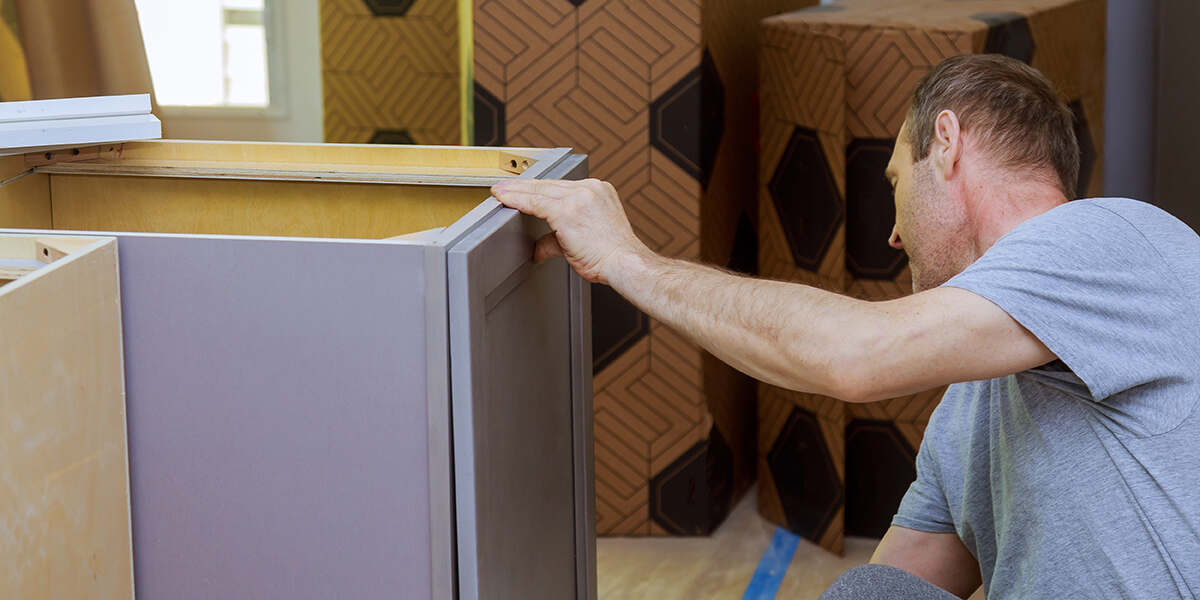Table of Contents
ToggleUnderstanding the Risks of DIY Cabinet Refacing
Are you thinking of a DIY cabinet refacing project but don’t know whether you can pull it off? Understanding the risks involved with doing a home renovation yourself can help you make the right decision.
As the trusted kitchen remodeling contractor in Hollywood, FL, Viteri Cucine can help you determine whether you can handle the project yourself. With considerable experience and competitive prices, we make hiring us extremely beneficial.

What Is Cabinet Refacing?
Refacing your cabinets requires a more extensive process than refinishing them. While refinishing only involves repainting or restaining a cabinet, refacing one involves installing a completely new cabinet door. However, it doesn’t mean you replace the entire cabinet.
Many homeowners also opt to update the cabinet’s hardware when they reface the cabinets. Refacing your cabinets is a great option if you have a good budget, want a new look for your kitchen, or have cabinets in poor condition.
Risks You Face While Refacing Cabinets
If you’re already aware of the risks of DIY home renovations, refacing your cabinets doesn’t provide an exception. Refacing requires you to overcome several challenges, all of which can pose significant obstacles if you’re inexperienced, untrained, and don’t have the right materials.
Lack of Knowledge
Your biggest risk during DIY cabinet refacing concerns the lack of knowledge you likely have. The project not only requires special tools like a sander, but the knowledge and skill to use them.
You should also know the right paint and veneer to use and the best methods of applying them. If this all sounds overwhelming to you, consider opting for a competitively priced professional to complete the work instead.
Extensive Time and Effort
Many homeowners underestimate the time it takes to complete the refacing process. Depending on the size of your kitchen, a professional team can complete the job in two to four days. If you’re doing the project yourself while also learning the skills and knowledge you need as you go, you could spend weeks completing the process.
Ask yourself how much you value your time and try to put a monetary value on it. For example, if you value your time at $25 an hour, and hiring a professional to reface your cabinets can save you 100 hours of work, you’re effectively saving yourself $2,500. Also factor in the money you save by avoiding mistakes, not voiding your warranty, and the convenience of not doing everything yourself.
Subpar Results
When you reface your cabinets by yourself, you’ll have to accept that the results won’t look as good as when you hire a professional. Even if you learn all the knowledge and skills you need, you won’t have the same level of experience as someone who does this every day.
That experience helps them adapt to challenges on the fly and avoid even minor mistakes that affect the quality of results. If you’re the type of person who can settle for “good enough,” then DIY cabinet refacing might work fine for you. Otherwise, invest in professional help.
Expensive Mistakes
While even the most skilled and experienced professionals make mistakes, homeowners completing a DIY project significantly increase the chances of an expensive mistake. The greatest risk includes damaging your cabinets, which means you’ll pay more to fix the issue. This can occur from measuring wrong, using the wrong equipment, or failing to handle your cabinets with care.
You also know that DIY projects usually yield lower-quality results than work from a professional. Consider the reduced home value that comes from kitchen renovations obviously completed by an amateur.
Health and Safety Concerns
Because cabinet refacing requires special materials and substances, doing it yourself can pose risks to your health and safety. Risks to your health include the toxic fumes from the adhesives and paint, especially if you don’t wear the right protective gear.
The process also requires working with various power tools. If you’re not used to this equipment, you could incur some severe injuries, even to the point of needing treatment in the emergency room.
Warranty Voiding
One concern that many homeowners overlook is the possibility of voiding the warranty on your cabinets. Most contractors or manufacturers only maintain the warranty if you have a professional do the work. If you already know your warranty has expired, you won’t need to consider this issue anyway.
The Cabinet Refacing Process
Whether you’re opting for DIY cabinet refacing or know a professional offers the best results, the process looks the same.
Gather Tools
To successfully reface your cabinets, you’ll need the following tools:
- Four-function screwdriver
- Nail and caulk guns
- Circular and miter saws
- Cordless drill and bits
- Wood file
- Laminate slitter and paper cutter
- Veneer tool
You can rent most of these tools or borrow them from friends and family. However, renting increases your overall costs. Also, ensure you know how to use each tool to prevent injuries during the process.
Detach Fixtures and Doors
Your cabinet’s fixtures include any handles you use to open them. The door consists of two parts, depending on its style: the frame, which usually outlines the perimeter of the door, and the front, which often looks inset compared to the frame. During this step of the process, you should remove the entire door from the cabinet and the fixtures from the door.
Reface the Interior
If the interior of your cabinets looks in poor condition, you should also reface the cabinet box. You can use either wood veneer or a rigid thermofoil (a type of laminate). You’ll need to accurately measure, cut, and adhere the material to the cabinet’s interior.
Wood veneer looks more natural, molds well to curved surfaces, and you can sand it to keep it looking new. Thermofoil resists heat and moisture better and offers a lower price point, but has less durability and you can’t repair it as easily.
Replace the Hinges
DIY cabinet refacing often involves replacing your hinges. If the old ones still look in good condition, you can reuse them. However, if you have to replace them soon, you should take this opportunity to update them at the same time.
Install New Interior Hardware
If you have hardware inside your cabinets, such as racks, shelves, or hooks, you can use the opportunity to refinish, replace, or upgrade them. If you have a cabinet without these amenities, consider adding them for increased convenience and functionality in your kitchen.
Attach New Doors or Fronts
As part of the refacing process, you probably purchased completely new cabinet doors. However, if the frame of your cabinet door looks in good condition, you may save some money if you only replace the fronts. Either way, once you’re satisfied with the quality of your interior cabinets, install your doors, which should look like new.
Upgrade Fixtures
While you could reinstall your old hardware, use the process as an opportunity to upgrade your style. Don’t underestimate the distraction caused by fixtures that don’t match the overall style of your home. You can rack up some considerable expenses choosing hardware, so work with a designer to find the perfect balance between quality and your budget.
Schedule Cabinet Refacing With Viteri Cucine Today
Are convinced you’ll get better results if you don’t try DIY cabinet refacing? At Viteri Cucine we use our experience, premium materials, and highly skilled designers and workers to always produce superior results. Whether you’re wondering about the steps before and after cabinet refacing or need design help, you’ll appreciate working with us every step of the way.
To start the process, fill out our online form or call (402) 505-3381.
- Mastering Contemporary Kitchen Design in Florida: Your Guide - 11/04/2024
- Latest Florida Modern Kitchen Cabinet Trends Revealed - 11/04/2024
- Do You Need a Permit To Remodel Your Kitchen? - 10/16/2024
